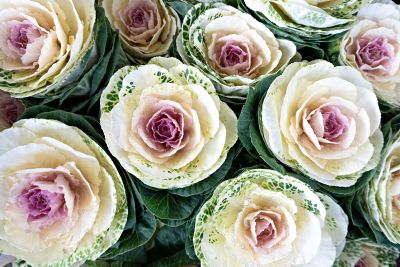About Ornamental Cabbage
Ornamental cabbage, also called flowering cabbage, has smooth, wavy edges with bright rosette centers of pink, purple, red, or white leaves. It grows about a foot (31 cm.) wide and up to 15 inches (38 cm.) tall with a mounding habit. Though considered edible– it has a very bitter taste– ornamental cabbage is more often used as a food garnish. It may be consumed with a double-boiling method to reduce bitterness or sautéed in olive oil. In the landscape, ornamental cabbage plants can be combined with flowering kale and late season annuals that can tolerate a frost such as petunias, chrysanthemums, and snapdragons. They look stunning in containers, in front of a border, as an edging, or in mass plantings. Their color intensifies as the temperature drops, particularly below 50 degrees F. (10 C.). Ornamental cabbage plants typically survive to about 5 degrees F. (-15 C.) and will decorate the landscape till winter turns harsh. FYI: While most people associate flowering kale and cabbage together as one plant, there is a slight difference when it comes to ornamental cabbage vs. flowering kale. Technically, the two are the same and in the same family, with both types considered kale. However, in the horticultural trade, ornamental or flowering kale plants have deeply cut, curly, frilly or ruffled leaves whereas ornamental or flowering cabbage has broad, flat leaves edged in bright contrasting colors.
Growing Flowering Cabbage Plants
Flowering cabbage is easily grown from seed but must be started by midsummer to be ready for fall planting. Light is needed for germination, so sprinkle seed on growing medium but do not cover with soil. Maintain temperature at 65 to 70 degrees F. (18-21 C.) to aid germination. Seedlings should emerge in four to six days. Keep temperature cool during growth period. Site them in full sun, with some afternoon shade where locations are very warm. They prefer moist, well-drained soil that is somewhat acidic. Fertilize with a timed-release fertilizer about three weeks after planting or moving to containers. If summers are too hot for growing seed, you may opt to purchase transplants from the garden center. Look for good color and a size appropriate for the desired planting area. Purchased flowering cabbage typically won’t grow much more after planting. When the temperature drops, colors should intensify, however. Ornamental cabbage plants are prone to the same pests and diseases as cabbage and kale grown in the garden, but much less so given the time of year. If noticed, treat with appropriate biological controls.
